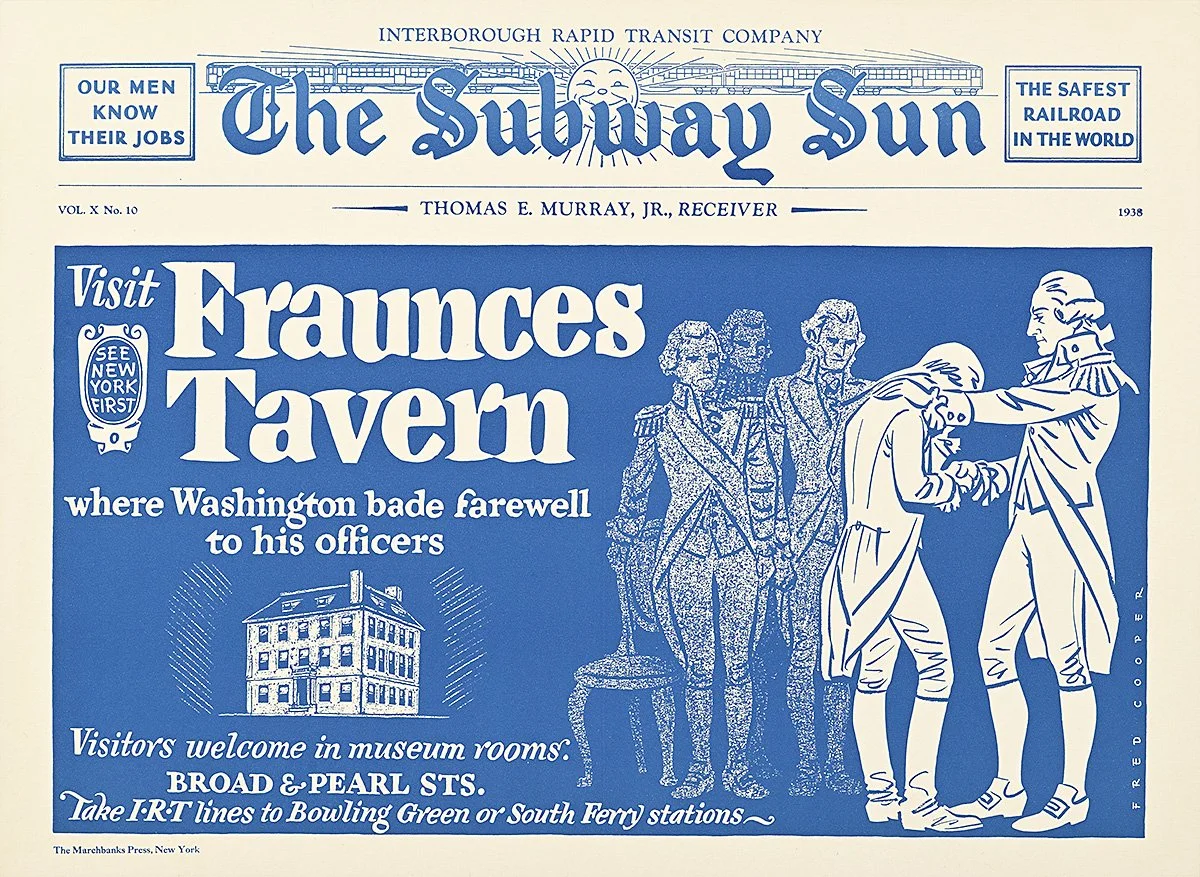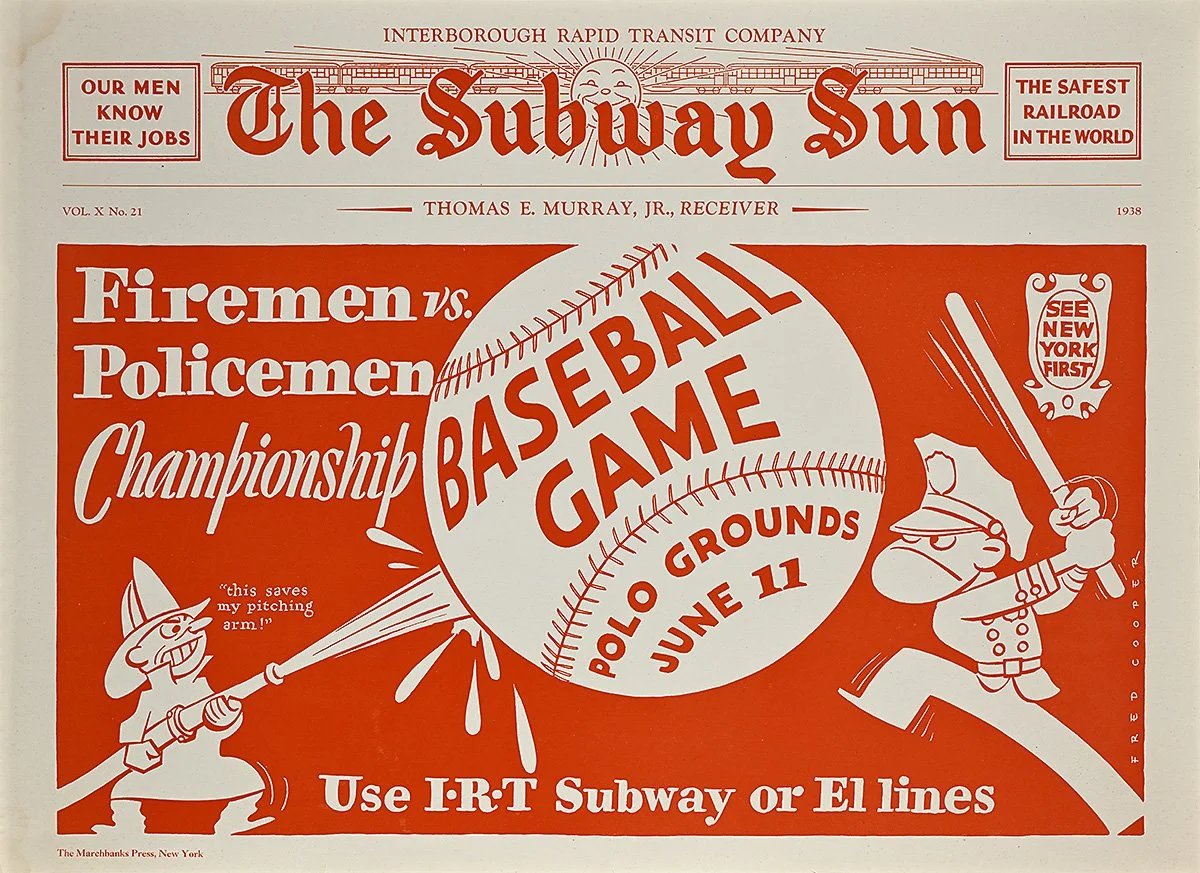Illustrating Your Ride: Fred Cooper and The Subway Sun
By Es-pranza Humphrey
When the Interborough Rapid Transit Company (IRT) opened to the public in 1904, there was an active effort to beautify the underground stations and its metal vessels in order to ease the anxieties of riders who were hesitant to travel throughout the unknown. The initiative to beautify included the presence of a variety of posters presenting transportation etiquette and advertising products and services as a way to capitalize on the fact that passengers spent an average of fifteen minutes in a train car during their commute. Among the advertisements for Viceroy Cork Tipped Cigarettes, Rheingold Lager Beer, and Heinz Cream of Tomato Soup, were a series of in-car posters that helped riders navigate the subway to visit some of New York City’s most scenic wonders. This series was called The Subway Sun.
Madison Square Garden, 1937, Poster House Permanent Collection.
But there was much more to using the subway system than interacting with travelers and commercial motivations. The IRT was also a mode of transportation that allowed New Yorkers to travel outside of their immediate communities and see the five boroughs that had consolidated by 1898. The city was brimming with historic sites, visual pleasures, and cultural hubs that the IRT urged riders to visit through the beautifully detailed and humorous publications of The Subway Sun. Starting in 1918, the series’ earliest iterations were fairly text heavy, with muted colors and the occasional photograph. However, when Fred Cooper (or Fred G. Cooper as he was most commonly known) took over as the lead illustrator in the 1930s, he elevated the design and intention of The Subway Sun in a way that countered the devastation of the Great Depression and echoed the vibrancy of the ever-evolving city.
Fraunces Tavern, 1938, Poster House Permanent Collection
It is a name that was once familiar in New York City. Fred Cooper is perhaps best known for his big-headed cartoonettes and his humorous takes on familiar topics, like using a prehistoric mother and child to note the early geographic features one could see in the Rock Garden at The New York Botanical Gardens. But his most impressive work is conveyed in his ability to showcase his knowledge of a given subject matter, seen especially in his Subway Sun poster for Fraunces Tavern, the oldest tavern in the United States and the site where George Washington bade farewell to his Continental Army in 1783. Cooper’s illustration is based on an 1883 Harper's Weekly engraving by Howard Pyle that depicts the scene as emotional and righteous, a thoughtful homage to the historic site.
Prior to his work with The Subway Sun, Cooper was known for his illustrations and hand lettering for Life magazine, where he showed off his versatility. He transferred this to his work with the IRT. In The Subway Sun, his cartoon characters and lettering were especially illuminated through the bright two-tone design of the posters. In his 1938 poster advertising a baseball game between the Fire Department and Police Department, Cooper playfully illustrates the fireman's resourcefulness to save his “pitching arm” by batting with his fire hose, iconography familiar to the profession. These posters were coupled with succinct directions to their destinations and in the case of “Firemen vs. Policemen Championship,” today’s viewers are teased with the mention of the now demolished Polo Grounds. The stadium opened in 1890 and was once located in Upper Manhattan, going through a number of rebuilds, expansions, and renovations until its demolition in 1963. The poster advertised the games hosted at the Polo Grounds between the city’s fire, police, and sanitation departments, events that drew large crowds and, with the help of the IRT, were accessible to New Yorkers near and far.
Firemen Vs Policemen, 1937, Poster House Permanent Collection
In addition to The Subway Sun’s initiative to have riders “See New York,” there was also an effort to remind people of proper codes of conduct, something still seen in subway ads today. Fred Cooper didn’t let etiquette minimize the upbeat tone of the posters as he continued to provide a level of sophistication in his illustrations. In the 1930s, the IRT primarily used train cars made entirely of steel with double-doors that opened on either side for passenger entrance. The poster features this style of train car while reminding viewers that blocking the subway doors on the IRT is a faux pas that will warrant an aggressive side-eye from other riders, an expression well illustrated by Cooper's riders in their 1930s attire of fitted suits and cloche hats.
Please Do Not Block, 1938, Poster House Permanent Collection
In 1915, Cooper commented on the work of a cartoonist, stating, “No matter how ridiculous a cartoonist's work may be, so long as it is really funny, especially when it portrays the intimate experiences and emotions of life, a remunerative market is certain.” He encouraged the cartoonist to keep their designs simple but wholesome. The Subway Sun displays this ethos quite well, as Cooper’s work is humorous but feeds on the reality of the everyday rider of the IRT. He illustrates the intimacy and excellence of the darling city that within thirty years of the advent of rapid transit, New Yorkers had grown to appreciate and proudly ride. The IRT was an innovation for many reasons and The Subway Sun expanded on its potential by allowing riders to experience all that the city had to offer…and all for five cents.
Es-pranza Humphrey is the Assistant Curator of Collections at Poster House in New York City. She has been featured in The New Yorker, ABC Here and Now, National Public Radio (NPR), the Fashion and Race Database and a number of international publications for her curatorial work.
Cabarga, Leslie, and Fred G. Cooper. The Lettering and Graphic Design of F.G. Cooper. Glenbrook, Conn: Art Direction Book Co, 1996.
Cartoons Magazine, Vol. 8. United States: H. H. Windsor, Editor and Publisher, 1915.
Fitzpatrick, Tracy. Art and the Subway: New York Underground. New Brunswick, N.J: Rutgers University Press, 2009.
Heller, Vivian, ed. The City Beneath Us: Building The New York Subway. New York: W.W. Norton & Co., 2004.
“IRT Subway Posters Available Online – University Archives.” Princeton University. Accessed June 16, 2025. https://universityarchives.princeton.edu/2008/09/irt-subway-posters-available-online/.



